Shout out to Sam Miller of Pebble Hunting for sending me down this rabbit hole.
What’s the best thing a pitcher can do early in the count? Some would say to generate first-pitch strikes. Getting ahead of the hitter puts you on the offensive and your opponent on the defensive.
For Kevin Gausman, that hasn’t been true in 2024.
OK. What’s the second-best thing a pitcher can do early in the count? Many would say earn a strike on the 1-1 pitch. The difference in hitting production between 2-1 and 1-2 is the most drastic in the sport.
That also hasn’t been true for Gasuman this year.
For Gausman, his disastrous 2024 all comes to a head in 0-2 counts.
Since reviving his career with San Francisco, Gausman has been among the league’s best arms. Only Zack Wheeler (19.8) and Corbin Burnes (17.5) have generated more fWAR since the start of 2021 (17.1). He ranks seventh among qualified starting pitchers in strikeout minus walk rate during the three-and-a-half-season stretch (23%).
Gausman’s 4.00 ERA and 5.12 xERA this year don’t quite align. Neither does his surprisingly low 23% strikeout rate, his lowest mark since 2018. And neither does his 1.3 fWAR, which ranks 37th among qualified pitchers. He’s allowed six runs in four of his 13 starts.
So, what’s up with Gausman?
Splitter Not Splitting
Over the past few seasons, Gausman’s added more horizontal, arm-side run to his splitter while reducing some of the vertical, drop-off-the-face-of-the-earth movement.
Take this splitter from 2021:
And compare it to this one from 2023:
See the difference?
Gausman’s turned it into one of baseball’s best offerings. Nobody has more Weighted Splitter Runs Created over the past four seasons (28.8). Opposing hitters whiffed at around 45% of them between 2020 and 2023. He generated almost 400 punchouts on the pitch between 2021 and 2023.
But this season, Gausman’s splitter has been a net-negative pitch.
The biggest problem I see is that—even with a consistent decrease in the metric over the past few seasons—the vertical drop on the pitch has reached a career-low.
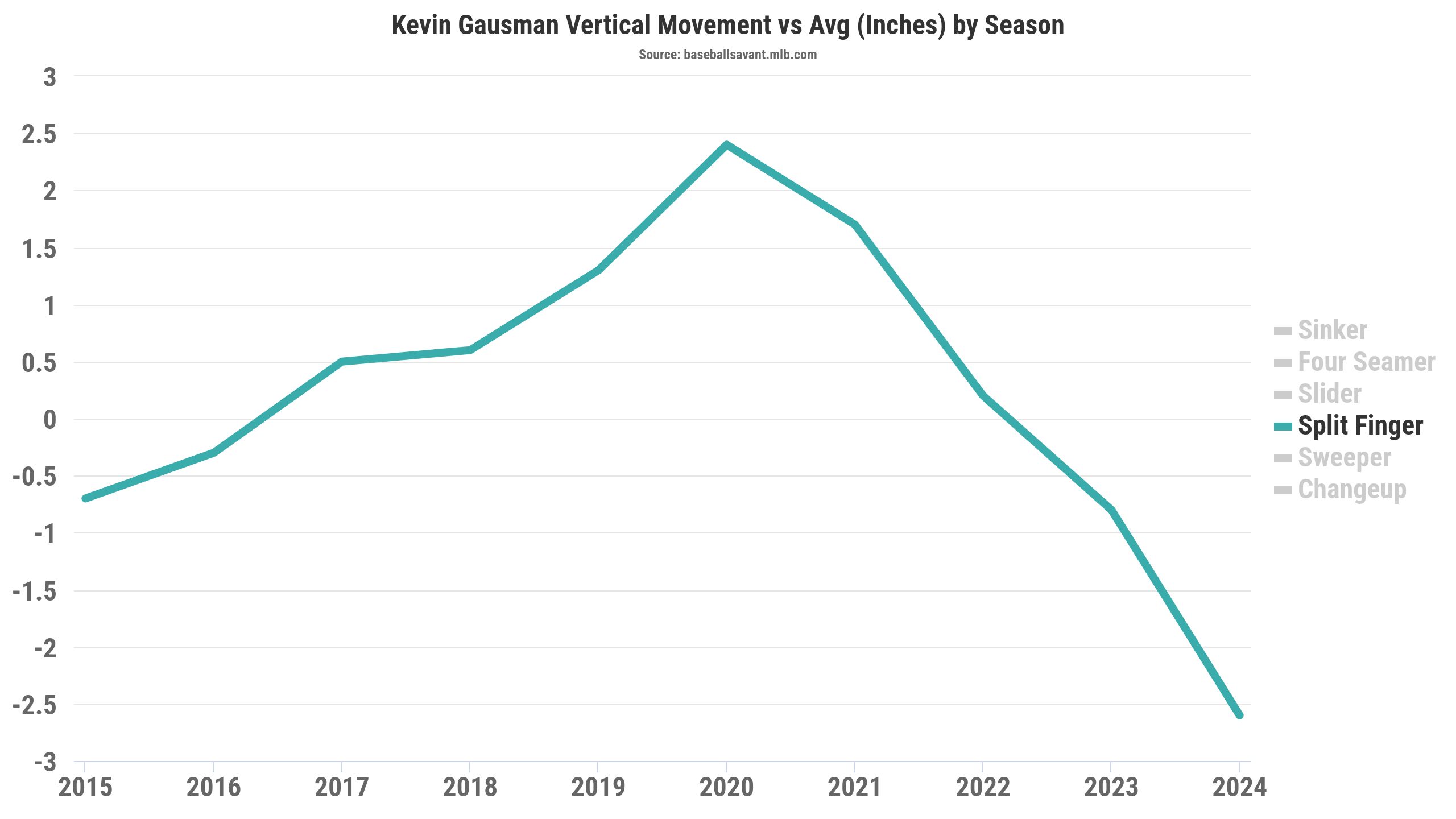
It’s just not breaking like it used to. So, for the first time since Eno Sarris released the Stuff+ model, Gausman’s splitter checks in below average.
But that’s only half the problem.
Velo Is Everything
Between 2020 and 2023, Gausman averaged around 95 mph on his four-seam. He posted a 107 Stuff+ mark on the pitch in the latter two years, and he generated a +16 Run Value on a 51% usage last year—it was the seventh-most valuable four-seam in baseball during the season.
But in his age-33 season, Gausman’s lost some steam.
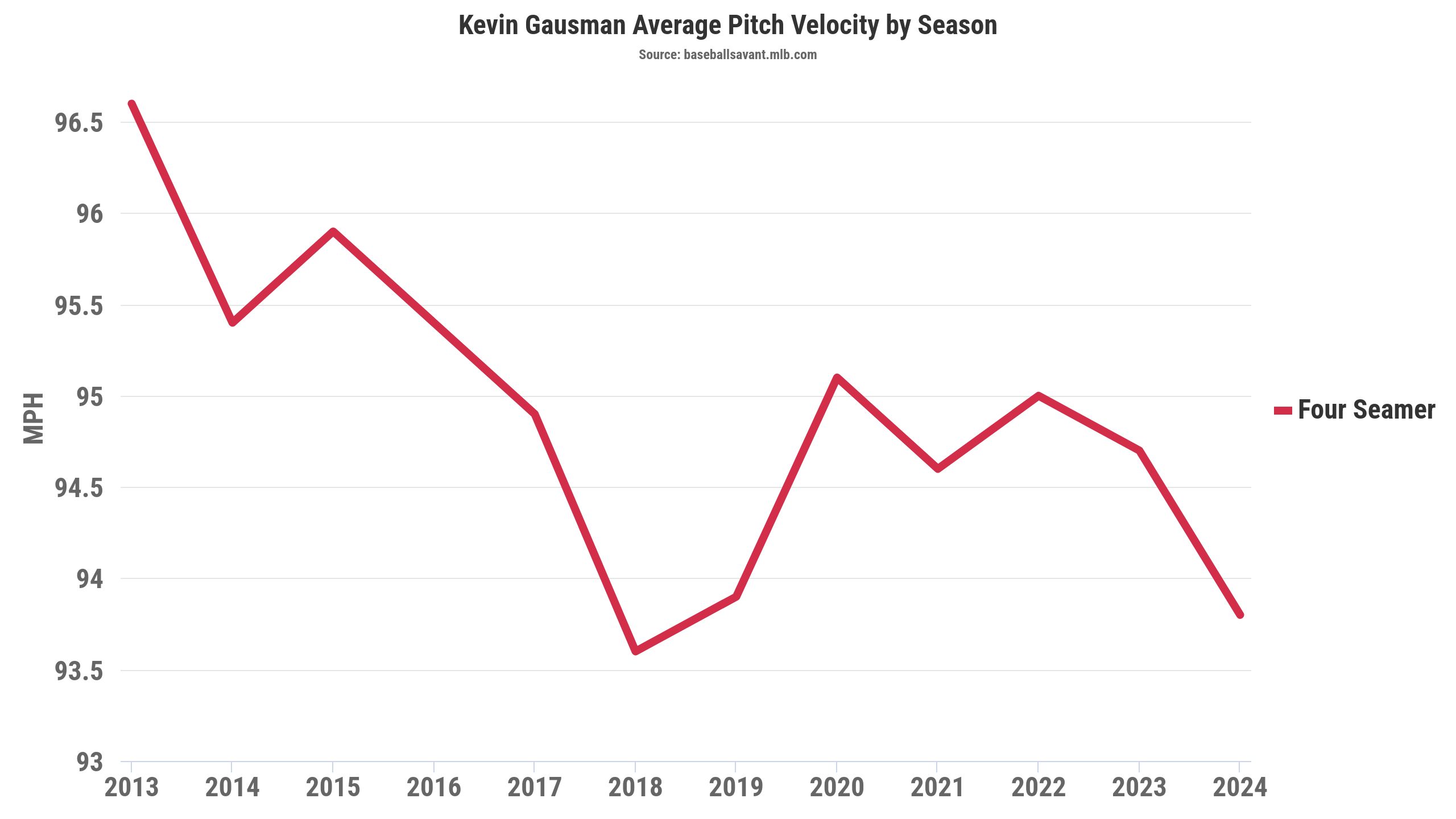
The heater still carries (16.6″ iVB, 80th percentile), and he’s actually added a bit of ride from 2023 (16.1″ iVB). The bigger issue is he’s leaving these lower-velocity, lower-stuff fastballs middle-middle (35%, 94th percentile) while painting almost none high in the zone (27%, last in MLB). As a result, hitters are barreling 18% of them.
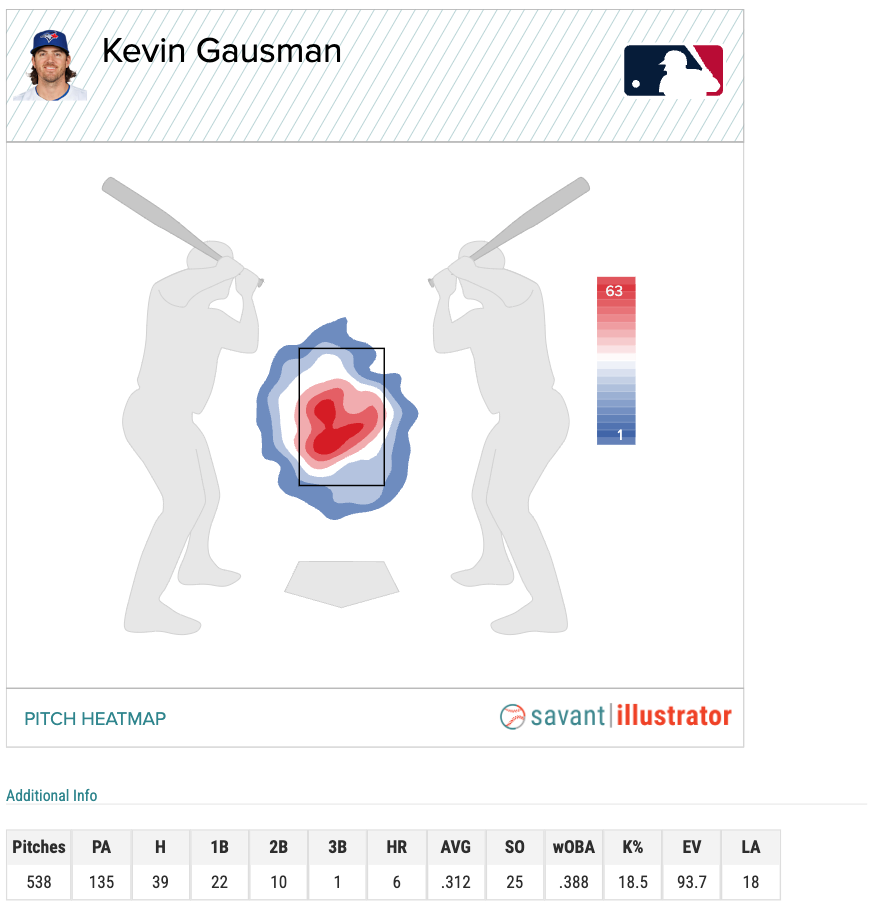
Velo truly is everything. We can somewhat predict a pitcher’s secondary metrics based on fastball velocity and effectiveness alone because everything plays off the heater.
Just Can’t Put ‘Em Away
For example, the split-finger fastball works because it plays off the fastball. Hitters identify the pitch as a four-seamer, initiating their swing right before the ball drops late and drastically.
The pitch’s deception comes from the velocity differential between the two pitches. And with Gausman’s fastball velo dropping, he can’t mess with the opposing hitter’s timing as effectively. Throw in the drastic decrease in vertical movement, and the splitter is playing more like a weak fastball.
This is the main reason for Gausman’s two-strike—and general—woes.
Gausman’s splitter has always been his main putaway pitch. He throws it nearly half the time in two-strike counts, hence why he’s generated so many strikeouts over the past few seasons.
But because it’s now a worse offering, the chase contact rate on Gausman’s splitter has jumped to a whopping 55%, seven points higher than last season. The zone-contact rate on the pitch is a crazy 86%, 15 points higher than in 2022.
As a result, the putaway rate on the pitch has dropped to a career-low 18%.
Across the prior three seasons, Gausman struck out 392 of the 892 batters he used a splitter against on the final pitch of the appearance (44%). This year, that number is down to 33 of 107 (31%). He’s allowed eight extra-base hits on splitters this season (7.5%) after allowing 20 in 2023 (6.6%) and 15 in 2022 (5.2%).
Gausman can’t miss bats with his current fastball-splitter mix. Combined with his heavy two-strike usage of his main secondary offering, he’s been continually roasted in pitcher’s counts.
Is It All That Bad?
My initial response to this whole situation is that Gausman is in huge trouble if he can’t fix his fastball, splitter, or both. The only other option would be a monster rehaul of his pitch mix.
But am I overreacting to a rough stretch in what’s been a dominant four-year run?
Gausman’s been messing with a sinker lately, which has produced solid results in a small sample size (5% usage, 100% ground-ball rate, 40% chase rate, .100 BAA against). He threw nine against Oakland in his last outing, his third-highest single-game total of the year.
He ended up throwing the first complete-game shutout of his career.
Kevin Gausman
First 9-inning, complete-game shutout on the road by a Blue Jays pitcher since Mark Buehrle on June 3, 2015 at Washington#TOTHECORE pic.twitter.com/vTuWBMj3vA
— Sportsnet Stats (@SNstats) June 8, 2024
Where in the world did that come from? He forced 13 whiffs on the splitter, the most of any outing this year, helping him strike out 10. His fastball returned four whiffs, eight called strikes, and 12 outs on 15 balls-in-play across 57 thrown.
So, has he fixed the problem? Is there nothing up with Gausman at all?
I doubt it.
His command looked better, but his fastball (86 Stuff+) and splitter (89 Stuff+) graded out well below average. His average fastball velocity was actually down in the start (92.6 mph), and his splitter wasn’t diving any more than usual.
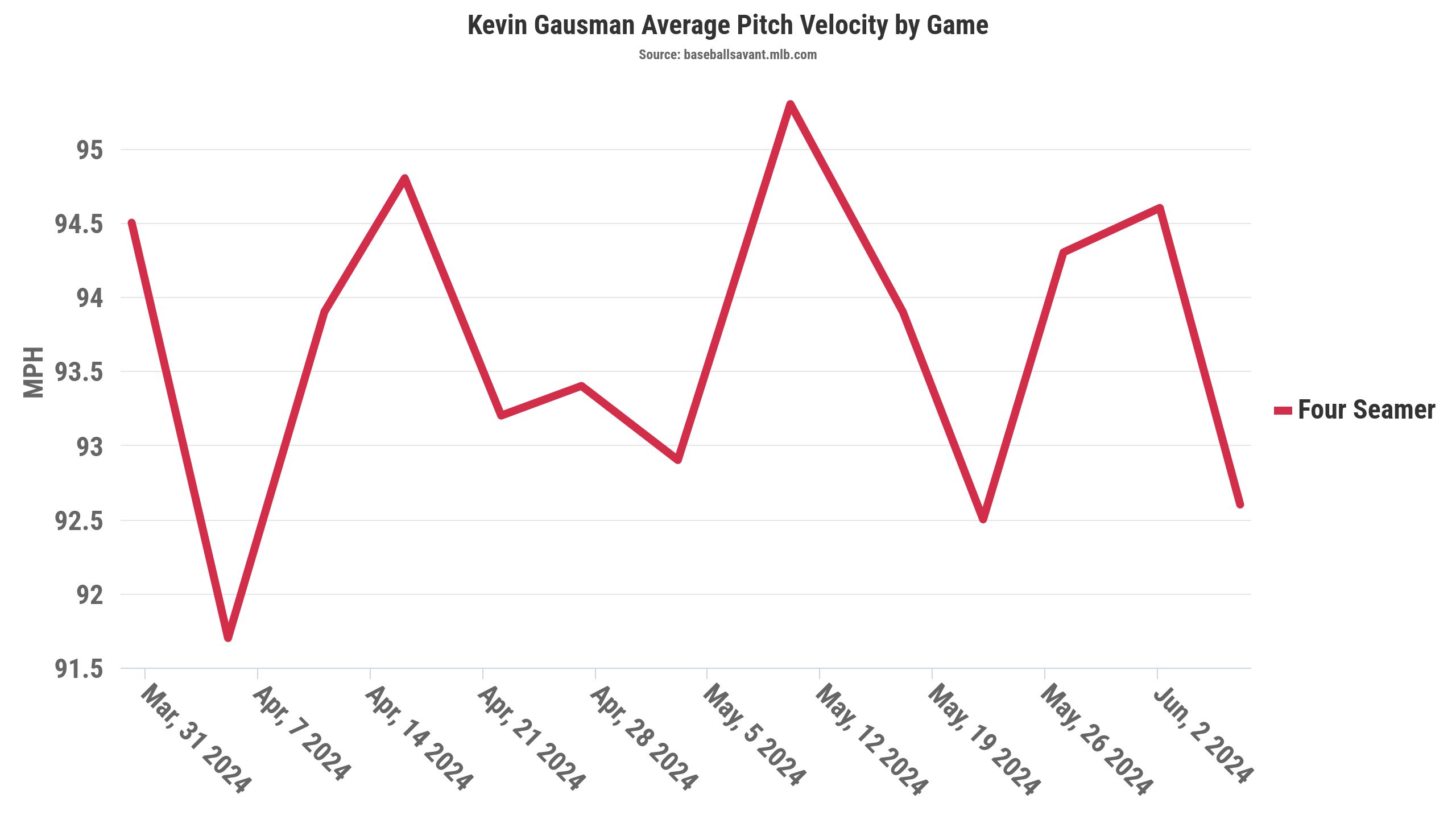
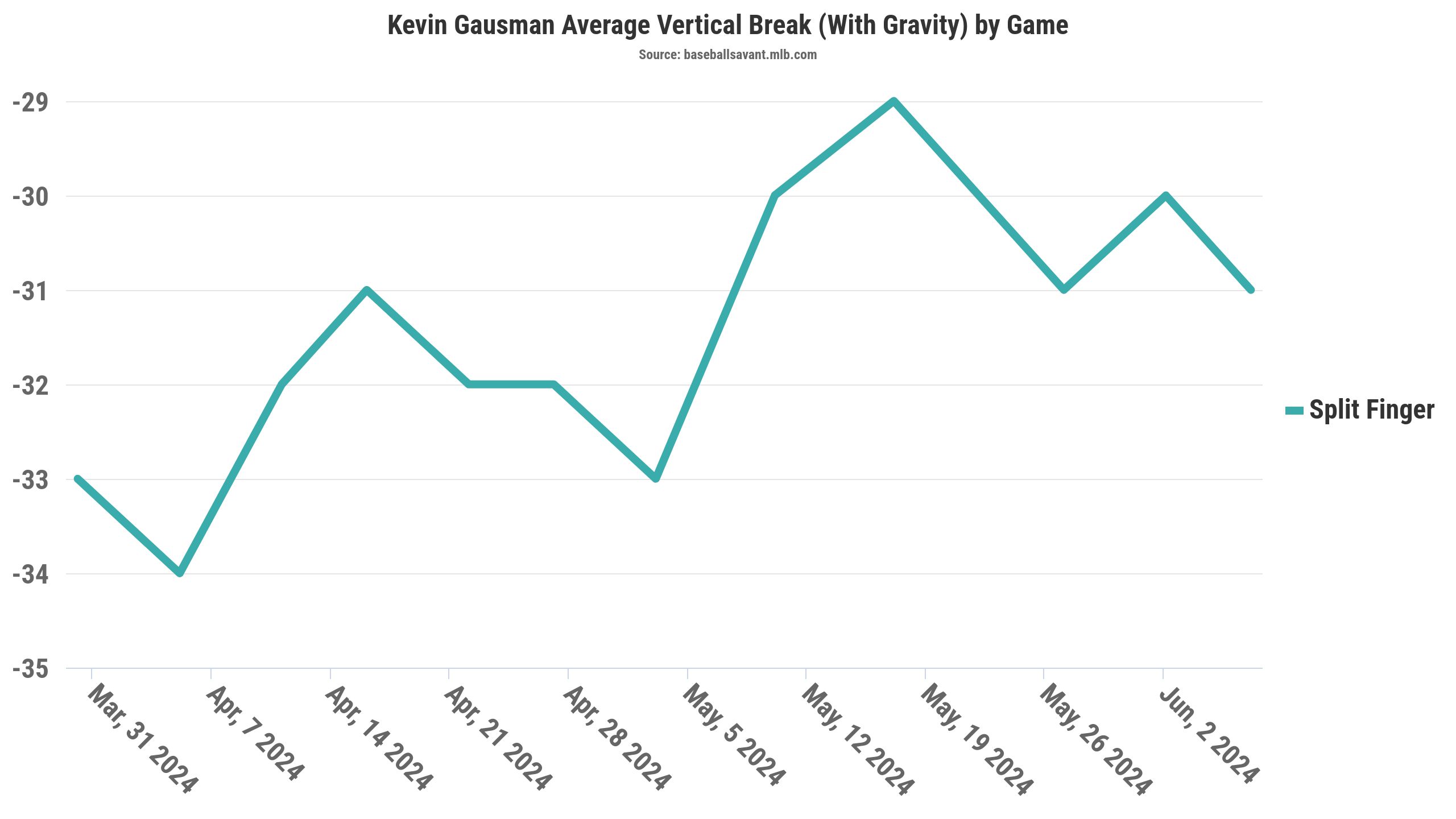
Unfortunately, this feels like a classic case of Blame It On The A’s, combined with throwing in a noted pitcher’s park. He allowed 10 fly balls (48% rate), three barrels (14% rate), and 10 hard-hit balls (50%), but they all stayed well within the friendly confines of Oakland Coliseum—for example, this hanging 0-1 splitter that Shea Langeliers barreled 390 feet with two ducks on the pond but was eventually hauled in by Kevin Kiermaier at the warning track.
Gausman’s had a few solid outings this year. He struck out 10 Tigers across six one-run innings on May 23. He struck out eight Nationals across five shutout innings on May 4. He had an impressive three-start stretch against the Dodgers, Royals and Yankees (18.2 IP, 2 ER, 13 K, 4 BB). He’s also still pitching decently well in non-putaway situations.
But Gausman’s fastball-splitter combination isn’t playing in two-strike counts, and that’s a massive issue because it’s his primary two-strike approach.
It’s why he allowed this monstrous 0-2 shot on a splitter to Aaron Judge on April 6 in a six-run outing.
It’s why he allowed this similarly monstrous 0-2 solo shot on a four-seam to Freddie Freeman on April 28.
That heater was almost as middle-middle as a pitch can get.
It’s why he allowed this 2-2 two-run ding-dong on a splitter to Austin Hays, his second of three homers allowed on that fateful evening 10 days ago.
I swear that pitch didn’t drop one inch.
And it’s why he allowed this 0-2 blast on a four-seam to Anthony Santander, his first of two two-strike homers allowed on that fateful evening 10 days ago.
As a faux Canadian resident, I pray that better days are ahead for Gausman. But I’m expecting the worst.
